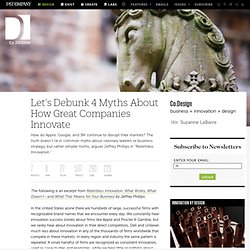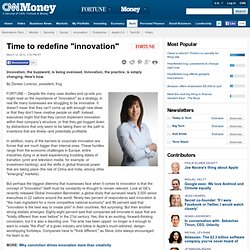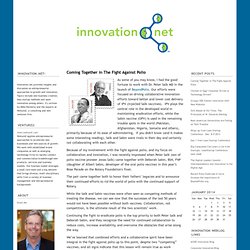

10%20Steps%20to%20Selecting%20the%20Right%20CI%20Software-%20A%20Practioner's%20Perspective. Un Blog de Gestión de la Innovación y la Gestión Humana- Dicamora: El nuevo papel de la Universidad en la Gestión del Conocimiento a través de la Transferencia de Tecnología. En una sociedad basada en el conocimiento, la Universidad se convierte en un elemento clave en uno de los procesos más importantes para el avance de la sociedad: la Gestión de la Innovación, tanto como proveedora de capital humano como promotora de nuevas empresas y tecnologías.

En la optimización de su infraestructura para implementar procesos de TT, las universidades como primer paso, deben crear o fortalecer las Oficinas de Gestión de I + D, para que se logre desde este punto desarrollar actividades para: Un blog para innovadores y emprendedores tecnológicos. The Innovation Lab. Let’s Debunk 4 Myths About How Great Companies Innovate. The following is an excerpt from Relentless Innovation: What Works, What Doesn’t--and What That Means for Your Business by Jeffrey Phillips.

In the United States alone there are hundreds of large, successful firms with recognizable brand names that we encounter every day. We constantly hear innovation success stories about firms like Apple and Procter & Gamble, but we rarely hear about innovation in their direct competitors, Dell and Unilever, much less about innovation in any of the thousands of firms worldwide that compete in these markets. In every region and industry the same pattern is repeated: A small handful of firms are recognized as consistent innovators, used as case studies and examples, while we hear little or nothing about innovation in the vast majority of the other firms in those industries.
Several possible factors spring to mind, including the executive management, the nature of the industry, or the capabilities of a firm’s research and development teams. W. Time to redefine "innovation" By Doreen Lorenzo, president, frog FORTUNE -- Despite the many case studies and op-eds you might read on the importance of "innovation" as a strategy, in real life many businesses are struggling to be innovative.

It doesn't mean that they can't come up with enough new ideas or that they don't have creative people on staff. Instead, executives might find that they cannot implement innovation within their company's structure, or that they get bogged down by distractions that only seem to be taking them on the path to inventions that are timely--and potentially profitable. In addition, many of the barriers to corporate innovation are forces that are much bigger than internal ones. The learning innovator (3/3) We have recalled some learning organization concepts and analyzed 3 innovation use cases in the two previous posts (The learning innovator 1/3 and 2/3).

I would like now to unfold a draft “learning innovator’s” role, and the way he could follow to modern innovation. The learning innovator Connecting the dots across experiences, continuously listen, learn and facilitate the learning of all members of the innovation team, so as to transform and develop the design potential to the full: this is the tough task of the “learning innovator”! Seldom will an organization excel in all knowledge management competencies (listen, learn, and facilitate learning), and neither will it benefit constantly from fair winds: the leading tip might well be to start from the situation potential, identifying the drivers that will bring the design one step further, in term of creation, development, and engagement.
Home. IXC UK - Using open innovation to drive business growth. Open Innovation – platform for innovation professionals. Ipgc. Innovation has always mattered in economic development.

But simply increasing spending on creating knowledge may not be the answer – we need to look at the whole system through which such knowledge translates to value creation. In a context where close to $1trillion/year is spent globally on R&D and where even the largest firms are moving towards ‘open innovation’ models this old question can benefit from a freshlook. This project explores the implications of the changing 21 st century context of networked, global and increasingly open innovation – a world in which knowledge flows become as important as knowledge creation. It involves a network of 5 UK universities – Cambridge, Cranfield, Imperial College, Liverpool and Loughborough working with the ESRC/EPSRC’s Advanced Institute for Management Research (AIM). The research covers 4 key questions: What is the (knowledge) context within whichinnovation occurs in the UK?
Innovation.net. (Image via Forbes) Recently, Industry Week published an article by John Dyer entitled "Does Management by Objectives Stifle Excellence?

" It's an intriguing article that challenges today's goal-focused management culture and implies that goals and metrics can sometimes get in the way of breakthrough thinking. Eliminating 'management by numbers and numerical goals' was one of W. Edward Deming's 14 points from his seminal quality book "Out of the Crisis" first published in 1982. When I worked for Ford Motor Company earlier in my career, I had the amazing opportunity to be trained by the legendary Dr.
W. Dr. Plenty of Dr. Among his greatest contributions to the world of managerial training are fourteen key principles for transforming business effectiveness, first written in his book Out of Crisis in 1986. InnoCentive. Open Innovation - Innovation Exchange.